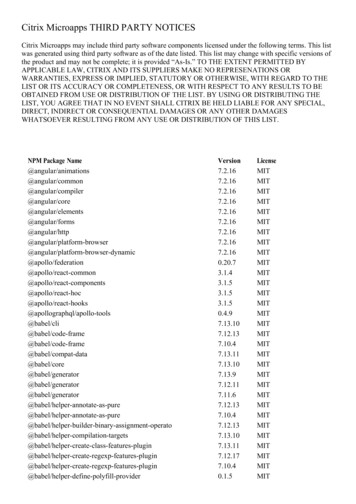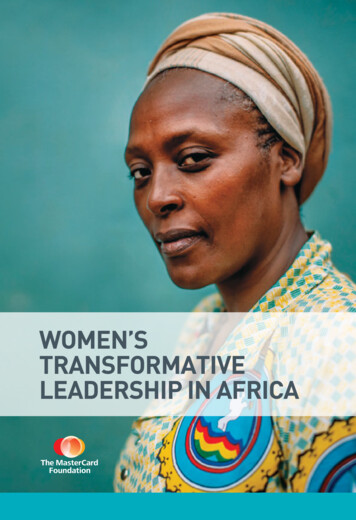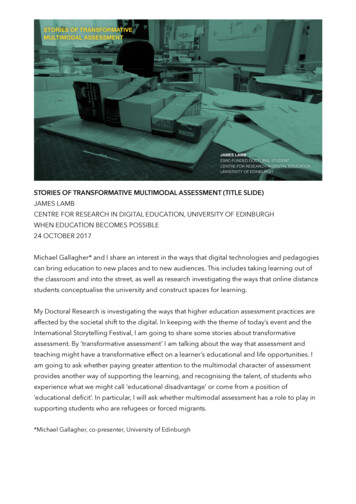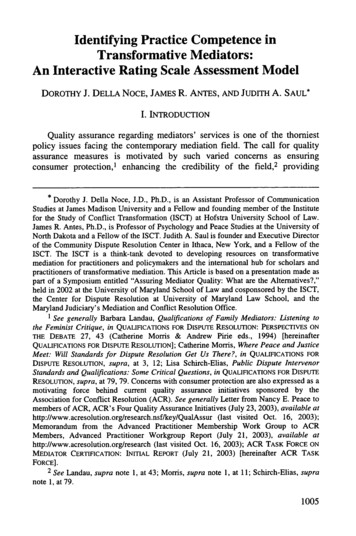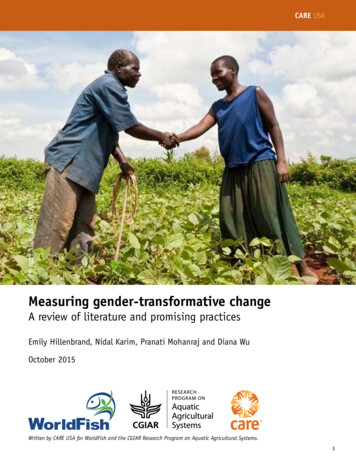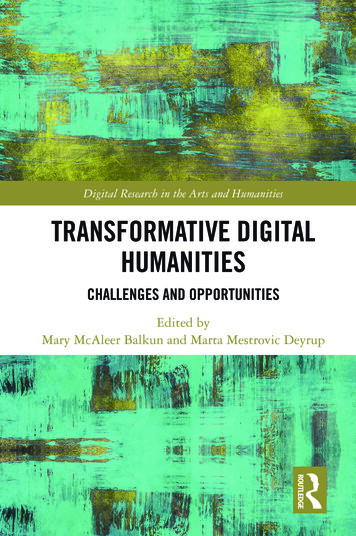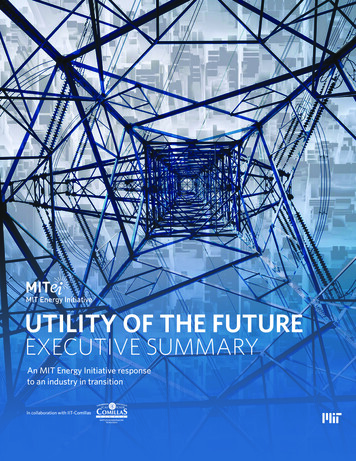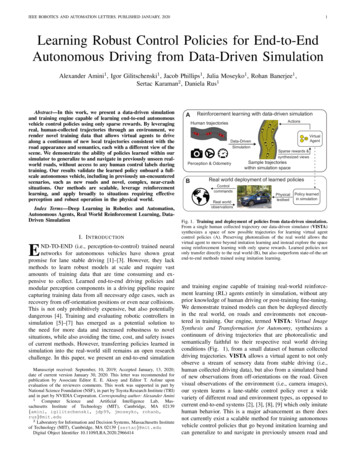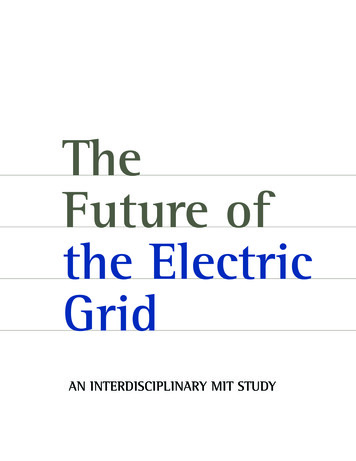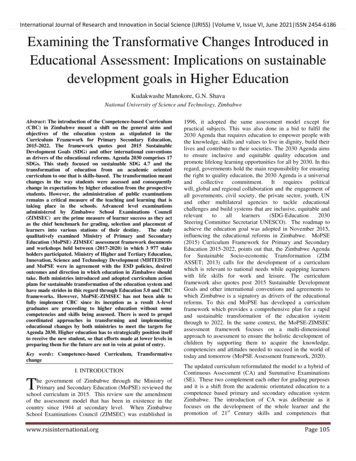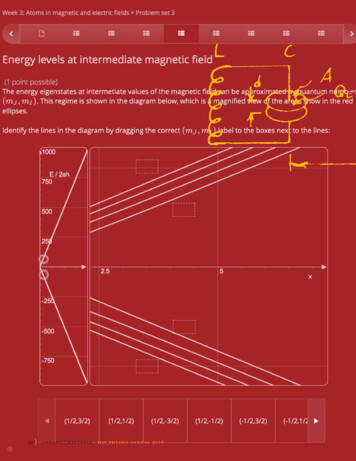
Transcription
54 )chuang ketterle mit physics annual 2016
A TransformativeTeaching Experiencein Atomic Physics at MITby Isaac Chuangand Wolfgang KetterleThis article describes the experience of the authors in teaching the atomic physics graduate course, what motivatedthem to develop an online version of it, and how they combinedthe online course material with interactive classroom sessions forteaching MIT graduate and undergraduate students. It also tellsthe story how one MIT professor, Wolfgang Ketterle (WK), whoemphasizes tradition in his teaching and research, and who usedonly chalk and blackboard in his early teaching, was inspiredby another MIT professor, Isaac Chuang (IC) to introduce newmit physics annual 2016 chuang ketterle( 55
t echnology into the classroom and eventually became a poster childfor MIT’s digital learning. And yet, he remains convinced thateducating students is much more than conveying knowledge; thebest teaching lets students experience the personality and passionof a teacher in an interactive environment.figure 1Sketch in the old course notes by Dan Kleppner to explain the van der Waals attraction betweenneutral atoms by the interaction of two semiclassicalLC circuits.The Atomic Physics course at MIT:technological evolution in teachingThe graduate course in Atomic and Optical physics, first taught by Dan Kleppnerin 1968 and further developed by David Pritchard, reflects the soul of the AtomicPhysics group at MIT. When one of us (WK) was a postdoc in 1990, he took hisfirst advanced atomic physics class from Dan and Dave, and enjoyed the manyspecial and sometimes unusual perspectives offered by this course, leading to a deepconceptual understanding of the underlying physics. The course went throughmajor developments: it was expanded to a two-semester course in the 1990s byone of us (WK), including laser cooling and trapped atoms. When WK taughtthe course with Vladan Vuletic, chapters on single photon physics and light-atominteraction were updated. When the two of us taught the course together, aspectsof quantum computation and entanglement were featured. The course notes wereoriginally written by hand (or with troff, a relic from the mainframe computerepoch), but were finally modernized to LaTeX and eventually shaped into astudent-editable wiki, in the early 2000s. Throughout all these developments, wepreserved the spirit and the tradition of the course. For instance, the course emphasizes the correspondence between classical pictures and the quantum mechanicaldescription (Figure 1). The students see the equations for Rabi oscillations for thefirst time in a purely classical treatment of a magnetic moment precessing in anexternal magnetic field. Such magnetic resonance methods were explored by I.I.Rabi and N. Ramsey, two pioneers (and Nobel laureates) who shaped modernatomic physics between 1930 and 1970. Their spirit can still be found in MIT’sAtomic Physics course, since Dan Kleppner’s PhD advisor was Norman Ramsey,who was a graduate student of I.I. Rabi. And WK was Dave Pritchard’s postdoc,who himself was Dan’s graduate student; atomic physics at MIT is a family affair!56 )chuang ketterle mit physics annual 2016
In 2005, we introduced the use of tablet computers in teaching the AtomicPhysics course; this offered a number of advantages. The write-up can be postedafter the lecture, eliminating the need for students to copy from the blackboard.It is possible to show the prior class write-ups at the beginning of the followingclass. The lecturer is facing the class when writing on the tablet, whereas at theblackboard he turns his back to the audience. It is possible to paste diagrams andfigures from original publications into the presentation, and tedious and not veryeducational parts of a derivation can be prewritten so that they take less class time.On the other hand, a smaller area is displayed (compared to large blackboards),and the lecturer is more static, being seated while writing. Over several semesters,we asked the class for their preference, and always a clear majority of the studentsvoted for the tablet over the blackboard.Motivated by Dave Pritchard and his quest for reaching individual students,another technology introduced into the Atomic Physics classroom was clickers, apersonal response system with which students respond to multiple choice questions, and the results are immediately displayed as a histogram. This addresses thechallenge of reaching silent students, who don’t respond or raise their hands whenthe lecturer asks a question. Clicker questions introduce a change of pace in theclassroom and get the students’ attention. If the histogram for a seemingly simple,but subtle concept question shows a similar number of yes and no responses, theclass realizes that they collectively don’t have a clue, and it creates an enormoussuspense, offering an opportunity to deliver an explanation in a memorable way.Originally, we expected that clicker questions would be a way to introduce shortexercises and control questions into the classroom. However, once we realized thepotential of the method, we became more and more creative in finding questionswhich addressed possible misunderstandings and invalid analogies. Eventually, wetook some pride in finding questions where the answers would form a flat histogram! With some of these questions we were able to entertain (and challenge) ourcolleagues at faculty luncheons. Those questions (and the questions and discussionstriggered by them) take classroom time away from other material, but overwhelmingly, when asked, the students wanted rather more than fewer clicker questions.The atomic physics lecture sequence was videotaped in 2013 and 2014 andpublished on MIT’s OpenCourseWare (OCW) site. The main motivations wereto document the MIT Atomic Physics course; to allow MIT students to watchlecture videos when unable to attend a lecture; and to allow students and professors worldwide to see how atomic physics is taught at MIT (see d-optical-physics-i-spring-2014/).Online course in the fall term 2015With MIT’s launch of edX, and a transition from OCW to more dynamic, massiveand open online courses, the Atomic Physics course was well positioned to transform and evolve to a higher level of sophistication, and also to contribute a uniqueoffering to the world.mit physics annual 2016 chuang ketterle( 57
figure 2Screenshot of the 8.421x MITx on edX courseon Atomic and Optical Physics, showing a graphicalhomework problem in one of the problem sets.For the worldwide MITx on edX course on Atomic and Optical Physics, thematerial was segmented into five modules and all the homework assignmentswere turned into online problem sets—meeting the challenge of creating inputmodules for responding to questions on advanced topics (Figure 2), the video lectures(Figure 3) were modularized and captioned, and in the Fall of 2015, the course wentonline, with MIT graduate TAs moderating the forum and answering questions.Overall, the course attracted over 6,800 unique participants (who registered andalso clicked at least once into the course material), and 217 unique individuals whoearned 430 completion certificates, spending over 12,000 hours on the course. Themost participants came from the U.S., India, Germany, and the U.K., respectively.Relative to country population, the top four countries were Greece, Canada, theNetherlands, and the U.S. On average, 4.8% of the participants earned certificates.Eighteen individuals earned certificates in all five modules. Only 13% of participants self-reported as being female, though this fraction was much higher (above20%) in Columbia, Poland, the U.K., and Greece. The course content comprised16 chapters with 331 videos and 228 problems; 58 of these problems were conceptquestions, presented interleaved with videos. The videos totaled over 26 hours,and on average were each a bit under five minutes in length. Assessments includedshort pre- and post-tests, to be analyzed by Dave Pritchard’s educational researchgroup for evaluating the learning experience; elucidating patterns in effective useof online materials; and studying item difficulty and discrimination.58 )chuang ketterle mit physics annual 2016
As faculty at MIT, since our primary mission is to provide the best educationto MIT students, we wanted to immediately try out how the new online materialcould be used in a residential setting, with MIT students. The physics departmentgave permission to have MIT students take the online MITx on edX course for fullMIT credit, when combined with weekly classroom discussions, a weekly recitation session, and a term paper. Just the right amount of students (six) signed up,enough to explore new formats in a small class setting, but not draining studentsfrom the regular residential class (which we teach in the Spring term). The weeklydiscussion sessions were a new experience. We realized how one could createdeeper insight by engaging the students in discussions about the topics of the videolectures. The discussions also revealed that the students may have understood thematerial superficially, but got confused when asked to show expert abilities, e.g.,to summarize limiting cases or describe the interplay of different concepts. Andthe students asked many questions, often challenging even for us. They asked formore discussion time, and we extended the weekly meetings from 1½ to 2 hourssince we couldn’t find a convenient schedule for additional meetings.The anonymous feedback questionnaire at the end of the semester did revealsome weaknesses, e.g., many typos in the wiki lecture notes, or incomplete solutionsto online homework problems. Also, most students said they would prefer a mixof online homework and traditional homework over online only.However, 100% of the respondents preferred the new format. All studentspreferred video lectures with discussion sessions over traditional classroom lectures.This was a striking and unexpected outcome. We are, as MIT professors, liveperformers—but now the students prefer videotaped lectures! One student wrote:“I cannot stress enough how helpful the video lectures are for this course. I’m thetype that prefers to take many notes during lecture, and I was able to get all of thatout of the way before ever coming to class. I could pause the videos as often as Ifigure 3Video shot of Wolfgang Ketterle in theclassroom, with annotated tablet slide content,as typically used in the online course.mit physics annual 2016 chuang ketterle( 59
figure 4Screenshot of the online course website for the Spring, 2016 residential “flippedclassroom” version of the Atomic Physicscourse.liked to make sure I’d written it all down. Then in the discussions, I could referto my earlier notes and add comments as they came up.”Eighty percent of the students found the discussion sessions “extremely helpful,”20% “very helpful.” One student commented: “Discussion session is very useful. Ijust hope I can get the material or note by professor so that I can review afterwards.These materials are so good that I even want to read them again in the future.”Spring term 2016 — flipping the classroomBased on this strong positive feedback from the experimental small section, wefelt we couldn’t merely stay with the usual format anymore, thus we overhauledtradition and deployed a new “flipped classroom” version of Atomic Physicsduring the Spring term of 2016, with an enrollment of 40 students, and WK as thelecturer. This new format had video lectures and online problems (Figure 4) andtwo or three classroom meetings each week (a total of 10 overview lectures and 10discussion sessions held by the lecturer, and 10 recitation sessions held by teaching assistants), plus a midterm exam and term paper. The online homework wascomplemented by three traditional problem sets that required written submissions,which were graded by the TAs. In the following, WK writes about the experiencefrom a first-hand and personal viewpoint.The flipped classroom experience was transformative for me. Without thepressure of covering lecture material in class (this was done by the video lectures),60 )chuang ketterle mit physics annual 2016
I could let discussions freely develop, deviate from my prepared material andoften make references to (or tell anecdotes about) the development of the field orrecent research. I felt that I could bring in all of my experience and personalityinto the classroom. This format encouraged many students to think through thematerial more deeply. In my more than twenty years of teaching at MIT, I havenever experienced such an interactive and engaging atmosphere. Students askedmany questions during class, and usually, after class, I had to stay for an extra 20or 30 minutes to address questions by students. I did not use the class time freedby the video lectures to introduce additional material, but added extra layers ofinterpretation and discussion. I often used atomic physics phenomena to discussgeneral aspects of quantum mechanics (coherence and decoherence, symmetryand selection rules) and how to interpret them in different ways, e.g., classically orperturbatively, or in terms of dressed states. In the middle of the semester, feelinguncertain if I met the needs of the students, I included in the feedback questionnaire whether I should put instead more emphasis on atomic physics material, but94 % of the students preferred the general quantum physics discussions.Five graduate students served as TAs for this class, and they also participated in,and reveled in the transformation. In particular, because most homework questionswere auto-graded online, the TAs spent less time doing mechanical grading andmuch more time offering office hours and presenting mini-lectures. As a result,they spent more face-to-face time with students, and creating new material to helpimprove understanding, e.g., by contributing to the wiki. Moreover, the TAs wereexcited by the potential for easily re-using all the video lectures, online problems,and wiki in their own future teaching careers.This overhaul of the Atomic Physics course is one of the largest it has ever seen,and it received enthusisastic feedback from some of the students. One studentwrote: “8.421 was my favorite class that I’ve ever taken. The online lectures freedup in-class time for engrossing free-form discussion sections that I miss greatlynow that the class has ended. I greatly preferred that style of teaching over thestandard in-class lecture format.”Still, there were issues to pay attention to, as revealed in the end-of-term feedbackquestionnaire. This showed that two thirds of the students were not involved inresearch in atomic physics, but took the course out of general interest or to fulfillthe breadth requirement. Since in discussion sessions, often the atomic physicsgraduate students asked questions, it is in hindsight not surprising that 50% of thestudent checked that “The discussion topics were often too advanced for me tounderstand, but still gave me a perspective,” or commented that the class shouldhave included more general motivation and more basic discussions. Going forward,it is not clear how to balance the interest of the expert graduate students with theneeds of students outside the field. One possibility would be to split the class timeinto more basic and more advanced topics.Some students were concerned about the work load: to watch video lecturesand attend classroom discussions and recitations two or three times a week. Wetried to reassure them by promising not to introduce additional material during theclassroom sessions, but rather help them to understand the material. Also, atten-mit physics annual 2016 chuang ketterle( 61
dance was optional, and they had the option of watching only the lecture videos,which would expose them to the same material presented in previous semesters.However, attendance of classes was very high throughout the whole semester. Inthe end, several students criticized the high work load (“I think that the formatis an excellent idea, but some serious work needs to be put in to make it take nomore time than a standard class”) and some redundancy between video lecturesand classroom discussions. On the other hand, one student observed this repetition positively, writing that “Wolfgang would give a live overview lecture, then Iwould go online and read the wiki notes, watch the detailed lecture video whiletaking notes, do the online problem set, and finally attend a second live lecturewith Wolfgang. Consequently, the basics of AMO are now as second nature to meas swinging a baseball bat.”Student opinion was divided about online problems. Fifty percent of the classliked the mix of online and paper homework, whereas 40% opted for paper only,and 10% want online only. Reading through the more detailed comments, itbecomes clear that for more complex problems and derivations, the paper formatwas preferred, but that students liked shorter and conceptual questions online withthe immediate feedback on whether or not they got the correct answer.Although the student’s comments show potential for improvements, we areconvinced that we have taken a big step into the right direction. Seventy percent ofthe students want us to “essentially keep the new format,” and some students wereeven enthusiastic: “I am thrilled I had the opportunity to take this course—I feelI have grown considerably in my understanding and in my capacity to engage infruitful research in AMO physics. The biggest success of the course was the enthusiasm, time and energy the teaching staff devoted to the course for the benefit of thestudents,” and one student simply stated that “all classes should be taught like this.”Future atomic physics teaching at MIT and beyondDriven by this transformative experience, we plan next to develop and deploy onlineand flipped versions of 8.422, the second semester of Atomic and Optical Physics.This is planned for the Spring of 2017, with versions for both MIT students andfor MITx on edX. We will take lessons from our on-campus, flipped classroomexperience and “flip” that again, to share with the worldwide audience how MIThas learned to teach this material. This may involve more discussion topics, anddeeper connections between MIT and worldwide learners.Teaching at the highest level and reaching out to the world is an important andintegral part of the Center for Ultracold Atoms (CUA), to which both of us belong.The CUA is an NSF-funded Physics Frontier Center [1]. The open, online AtomicPhysics course helps connect the CUA with the general public and the scientificcommunity. A graduate level online course in Atomic Physics is important, sinceatomic physics is a smaller subfield of physics and there are many universities whichhave no faculty in atomic physics, or too few to reach the critical mass to teach sucha course. The CUA is among the world-leading places for atomic physics, and has62 )chuang ketterle mit physics annual 2016
an exciting research program in exploring the quantum world with atoms andlight, and engineering and studying new quantum materials. The Atomic Physicscourse, and CUA faculty, have educated many students and postdocs who are nowin leading positions around the world, and we hope that they are also inspired touse new approaches to teaching.reference[1] Despite CUA successes, support from the National Science Foundation isdecreasing, reflecting a general trend in the federal funding of fundamentalscience. To continue its mission, the CUA is trying to attract additionalsponsorship; feel free to contact us for more information.professor isaac chuang is a pioneer in the field of quantum information science.His experimental realization of two, three, five, and seven quantum bit quantum computersusing nuclear spins in molecules provided the first laboratory demonstrations of manyimportant quantum algorithms, including Shor’s quantum factoring algorithm. The errorcorrection, algorithmic cooling, and entanglement manipulation techniques he developedprovide new ways to obtain complete quantum control over light and matter, and lay afoundation for possible large-scale quantum information processing systems.Chuang came to MIT in 2000 from IBM, where he was a research staff member.He received his doctorate in Electrical Engineering from Stanford University, where hewas a Hertz Foundation Fellow. He also holds two bachelors and one masters degrees inphysics and electrical engineering from MIT, and was a postdoctoral fellow at Los AlamosNational Laboratory and the University of California at Berkeley. Chuang is the co-author,together with Michael Nielsen, of the textbook Quantum Computation and QuantumInformation.professor wolfgang ketterle does experimental research in atomicphysics, exploring new forms of matter of ultracold atoms, in particular novel aspects ofsuperfluidity, coherence, and correlations in many-body systems. His observation of BoseEinstein condensation in a gas in 1995 and the first realization of an atom laser in 1997 wererecognized with the Nobel Prize in Physics in 2001 (together with E.A. Cornell and C.E.Wieman). His earlier research was in molecular spectroscopy and combustion diagnostics.Ketterle received a diploma (equivalent to a master’s degree) from the Technical Universityof Munich (1982), and a PhD in Physics from the University of Munich (1986). Afterpostdoctoral work at the Max-Planck Institute for Quantum Optics in Garching, Germany,the University of Heidelberg and at MIT, he joined the physics faculty at MIT (1993), wherehe is now the John D. MacArthur Professor of Physics, Director, MIT-Harvard Center forUltracold Atoms, and Associate Director, Research Laboratory of Electronics.His awards include a David and Lucile Packard Fellowship (1996), the Rabi Prize ofthe American Physical Society (1997), the Gustav-Hertz Prize of the German PhysicalSociety (1997), the Discover Magazine Award for Technological Innovation (1998), theFritz London Prize in Low Temperature Physics (1999), the Dannie-Heineman Prize ofthe Academy of Sciences, Göttingen, Germany (1999), the Benjamin Franklin Medal inPhysics (2000), the Nobel Prize in Physics (2001), the MIT Killian Award (2004), and aHumboldt research award (2009).mit physics annual 2016 chuang ketterle( 63
to MIT students, we wanted to immediately try out how the new online material could be used in a residential setting, with MIT students. The physics department gave permission to have MIT students take the online MITx on edX course for full MIT credit, when combined with weekly classroom discussions, a weekly recita-tion session, and a term paper.
